The number of remote workers, otherwise known as telecommuters, is on the rise.
People have become accustomed to a new lifestyle, one where they can work on their own terms, from wherever they choose. This new way of working has left employers scrambling to catch up, investing in new tools and software to allow employees to work remotely.
Is this drastic increase in remote working here to stay, or will people gradually return to the office? Perhaps we’ll see more of a blend between the two, otherwise known as hybrid working. We delve into remote work statistics to find out.
So, if you’re curious about what impact remote working has had on businesses and employees, read on for the top 2020 remote work statistics and what this means for hybrid working.
Overview of 2020
Due to the pandemic, 2020 has forced many people to remotely. And with that, it has unveiled a desire for a flexible working life moving forward. In fact, 92% of people expect to be able to work from home at least once a week after the pandemic subsides2.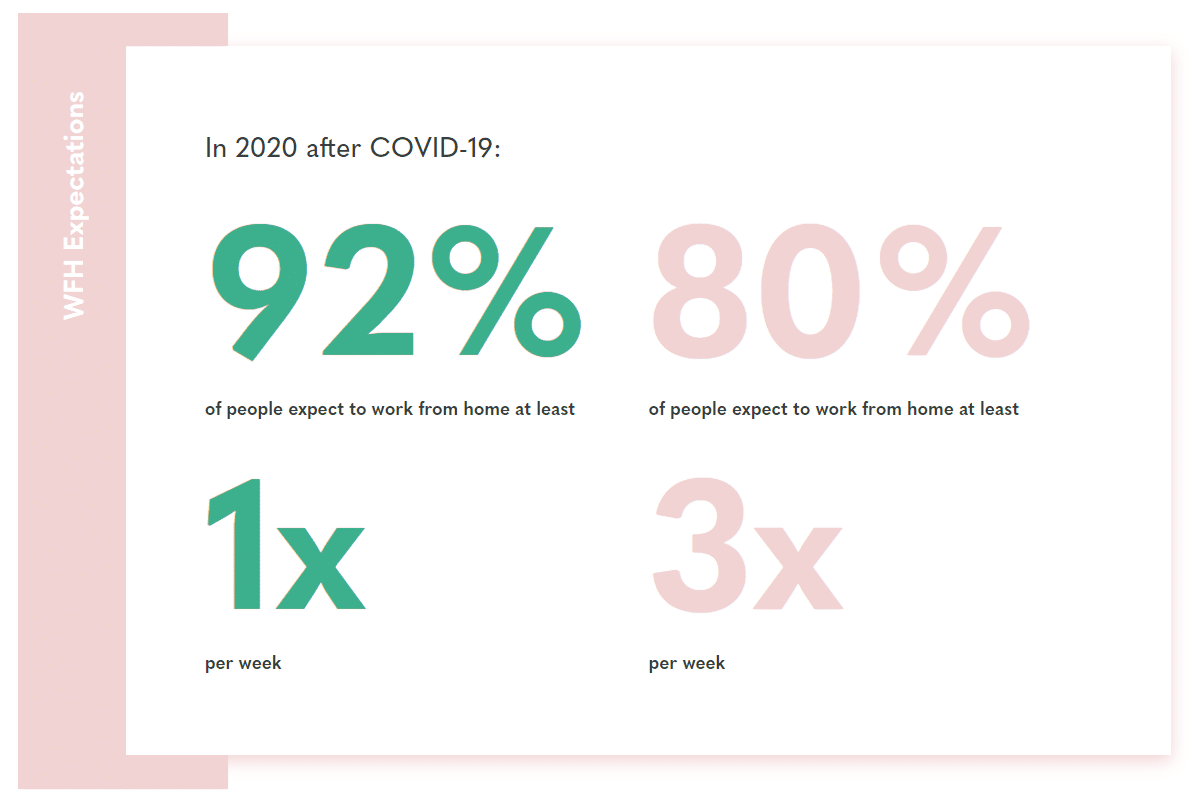
Here’s what some other statistics tell us about 2020:
- As of April 2020, 67 per cent of organisations reported an increase in spending on web conferencing software.3
- Home is consistently the number one primary work location for remote workers.4
- After the coronavirus pandemic, if people were unable to continue working remotely, 66% said they would stay but be less happy.5
Even before the events of this year, companies were beginning to let employees work more flexibly. Whether you’re working part-time or full-time, working from home some days of the week has become the new normal for many. This is usually made easier if you’ve got a home office. Although remote work offers great flexibility to work wherever you want to, most people still choose to work from home, though where that home may vary dramatically. Having a dedicated space can be beneficial for productivity and offer fewer distractions.

Perhaps in the coming years, this will change as people become more confident with this new working way of life. Coffee shops and co-working spaces are likely to experience an influx of visitors as more people decide to switch to remote working. But in 2020, remote work was all about working from wherever you can, which was usually the kitchen table.
Technology is a huge part of this remote work shift. Without astounding developments in technology in the past decade, people wouldn’t be able to work remotely the way they do today. Given the year that 2020 has been, this would have had an even more detrimental impact on many businesses. Now, at the touch of a button, you can connect with your team from a home office with cloud-based calling software like RingCentral.
Key remote work statistics
Let’s take a look at some key remote working statistics from 2020 before investigating what this means for hybrid working.
Remote work growth
1. Regular work-at-home has increased by 173% since 2005. (Global Workplace Analytics)
Thanks to amazing advances in technology, more people than ever can work from home. With video conferencing and audio calling software like RingCentral, remote communication has never been easier. It’s easy to see why employees working from home regularly have increased by 173% since 2005, as anyone can fulfil their work duties effectively from home.
2. 88% of organisations have encouraged or required employees to work from home due to the coronavirus pandemic. (Gartner)
This survey of 800 global HR executives revealed that many businesses had asked employees to work from home, whether they show any covid symptoms. What’s more, 97% have cancelled work-related travel, leaving meetings to be conducted virtually. This is an increase of more than 80% since March.
3. If they could, 98% of people would choose to work remotely, at least part-time, for the rest of their careers. (Buffer)
This statistic demonstrates the growing demand for flexible working. Employers have started to become more open to employees working from home, at least for some part of their career. Besides, 97% of respondents said they’d recommend remote working to others.
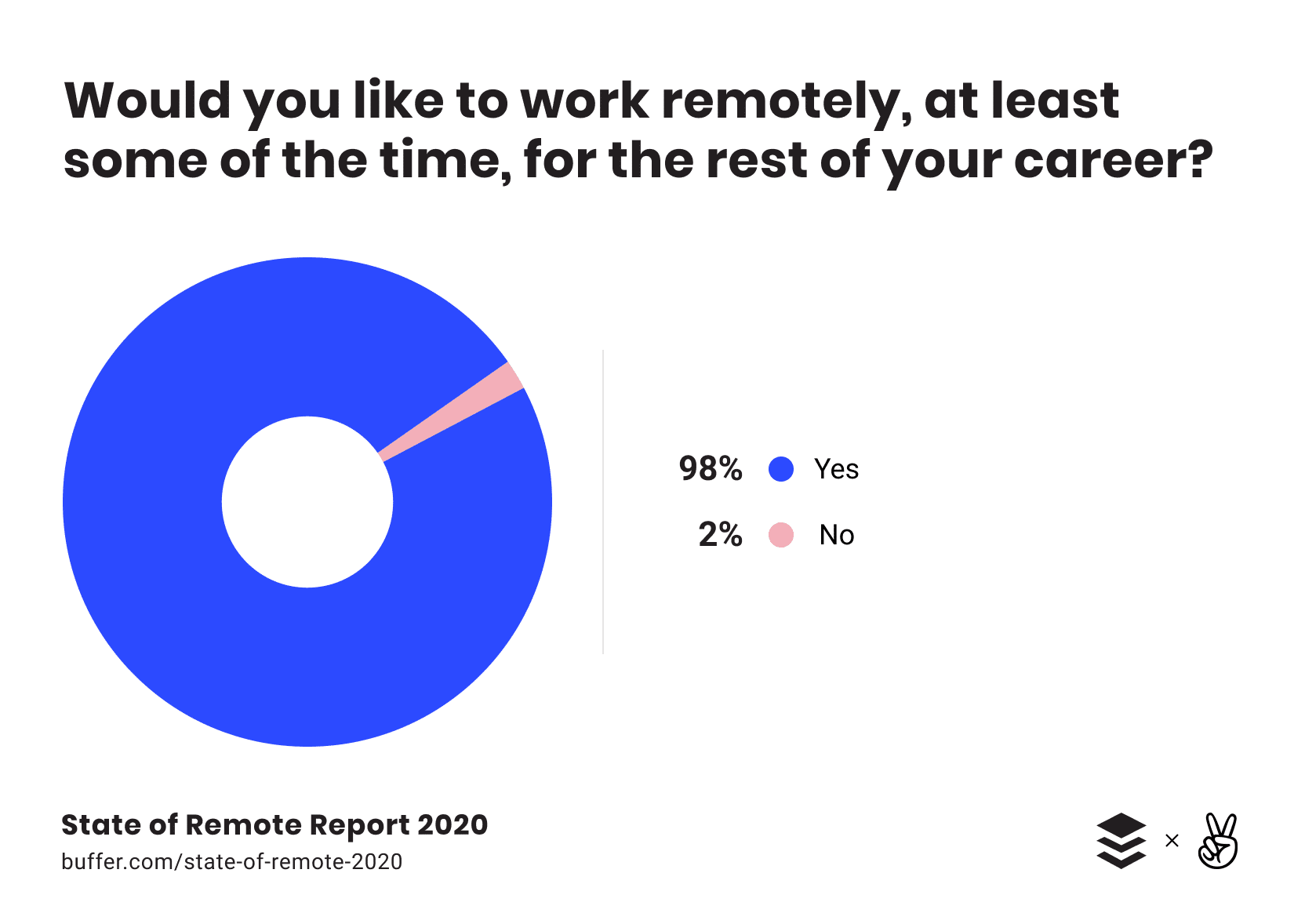
4. 52% of global employees work remotely once a week. (Owl Labs)
Overall, more people work remotely at least once a week than those who don’t at all. What’s more, 68% do so at least once per month. This may be once over the weekend, or during a day during the working week. Either way, this telecommuting trend looks set to continue as the popularity of hybrid working grows.
Job opportunities and job retention
5. 41% of people would be likely to resign if they were forced to return to the office against their will after working remotely. (Owl Labs)
This remote work statistic shows that people have become used to working from home, and once they get a taste for it, they aren’t always so willing to return to the office. So much so, that they are prepared to resign from their job if it means they can’t continue working from home.
6. 54 per cent of office workers would leave their job if they could have one with more flexibility. (Gallup)
Business owners need to be aware of this remote work statistic because it could ultimately impact employee retention. Offering remote work opportunities may help keep employees in their job and prevent them from looking at other jobs that do offer remote work.
7. U.S. companies that allow remote working has a 25% lower employee turnover rate. (Owl Labs)
As we’ll come to see, employees can be happier and more productive when working remotely. So, it makes sense that they’re likely to stay with their employer when they’re given this opportunity.
8. 1 in 2 people don’t want to return to jobs if they don’t offer remote work. (Owl Labs)
Owl Labs study found that 1 in 2 people surveyed are unwilling to return to jobs if they don’t offer some remote work flexibility. This could mean employers are potentially losing valuable employees simply because they don’t offer remote working options.
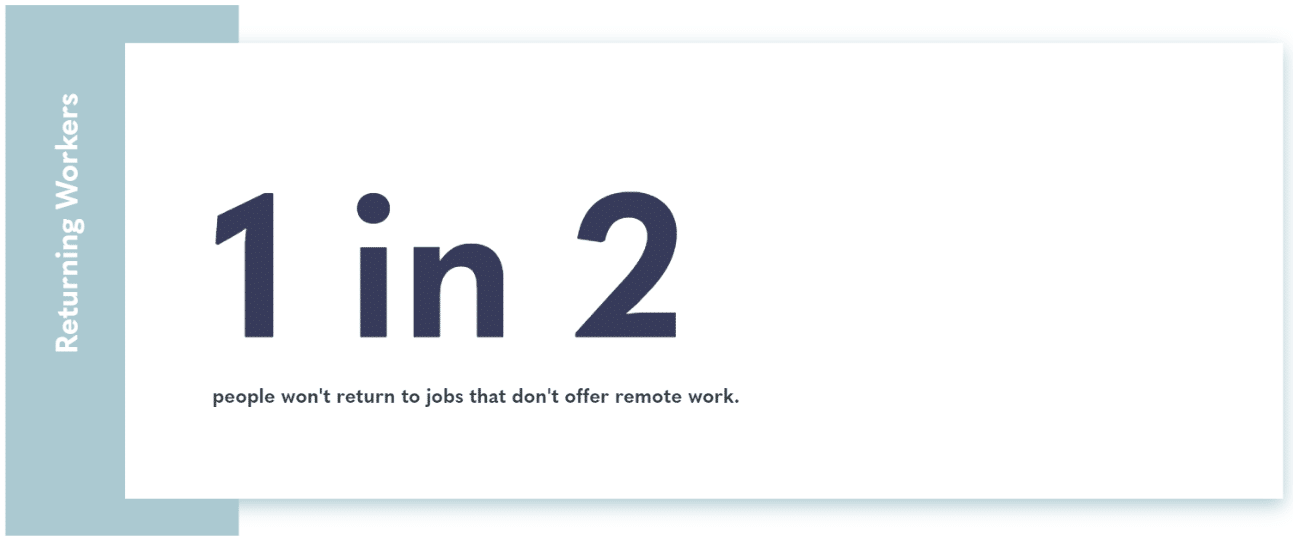
Employee communication and engagement
9. 32% of organisations have introduced new tools for virtual meetings. (Gartner)
Because of the move to remote work, many businesses have found themselves conducting meetings and conferences virtually. Using software like RingCentral can help transition from office to home, thanks to its team messaging and video conferencing tools. This helps to keep communication within the team-high, even though they’re working apart.
10. More than 75% of people said they feel more trusted at work while working remotely. (Owl Labs)
Workers aren’t being watched as closely when they’re working remotely, so managers can’t always keep a close eye on what employees are up to. As we can see from this remote work statistic, it appears that this makes many people feel more trusted by their employers.
11. People are using video meetings 50% more than before the pandemic. (Owl Labs)
Video meeting usage has increased by half since before the coronavirus pandemic. This may mean that many businesses have had to invest in additional software to keep up with this new working way. RingCentral is a popular choice for many businesses for video meetings. It allows you to video call in HD and has up to 100 participants in the meeting with you, making it a great choice for small and larger businesses. Not only this, but it also has many app integrations to make the transition to working from home a little smoother, including Gmail and Salesforce.

Employee productivity and WFH benefits
12. 32% of people said the biggest benefit of working remotely had a flexible schedule. (Buffer)
There are always going to be challenged with remote work, but for the most part, employees enjoy a range of benefits. A further 26% of people said they liked the flexibility of working from anywhere, and 21% of people said they liked not having to commute. Many employees are pleased with their improved work/life balance.
13. 57% of remote workers think they are more productive when they work from home. (Indeed)
If more than half of the people surveyed said that they feel more productive when working from home, employers might want to consider letting more people work from home to increase their productivity. However, this may differ from person to person. Having the option is great for those who feel more productive at home and beneficial to those who want to stay in the office. This may create a hybrid workforce, with some members of the team working remotely and others in-office.

14. An Airtasker survey found that 37% of remote workers stay productive by taking breaks. (Airtasker)
For some, staying motivated while at home can be difficult. Taking regular breaks can help with this, and also reduce time staring at a screen. Employers should encourage employees to take breaks more often to be more productive once they return to their desks. Flexible hours may be beneficial here, allowing staff to work when suits them, rather than the standard 9 to 5.
Remote work for the environment
15. Xerox calculated that it saved 92 million miles of driving by allowing its remote workers to avoid commuting. (Gallup)
Carbon emissions from their employees alone were reduced by almost 41,00 metric tons. If more companies encouraged remote working, there would be less cause to commute each day – this could potentially have a beneficial impact on the environment.
16. A part-time telecommuter saves the equivalent of 11 workdays per year in time they would have otherwise spent commuting. (Global Workplace Analytics)
The study also revealed that extreme commuters save more than three times that amount. Not only does this benefit employee, but it also benefits companies who may contribute to travel costs.

Challenges of remote work
17. 29% of US employees said they miss the visibility of being in the office and training and career progression opportunities. (Owl Lab)
Some people miss being around their colleagues, work perks, and having that daily contact and bonding time. This statistic also shows that they fear they may miss out on career progression opportunities because they’re not in the office.
18. 20% of people cite collaboration and communication as one of the biggest struggles of working remotely. (Buffer)
Not all teams are prepared to work remotely straight away, and some struggles can arise as team members adjust to their new flexible working schedules. When communication and collaboration are an issue, it’s a good idea to invest in tools that help bring the team together, such as a video or audio call and team messaging. WFH can take some time to get used to, but it can make communication easier when you’ve got the right software.
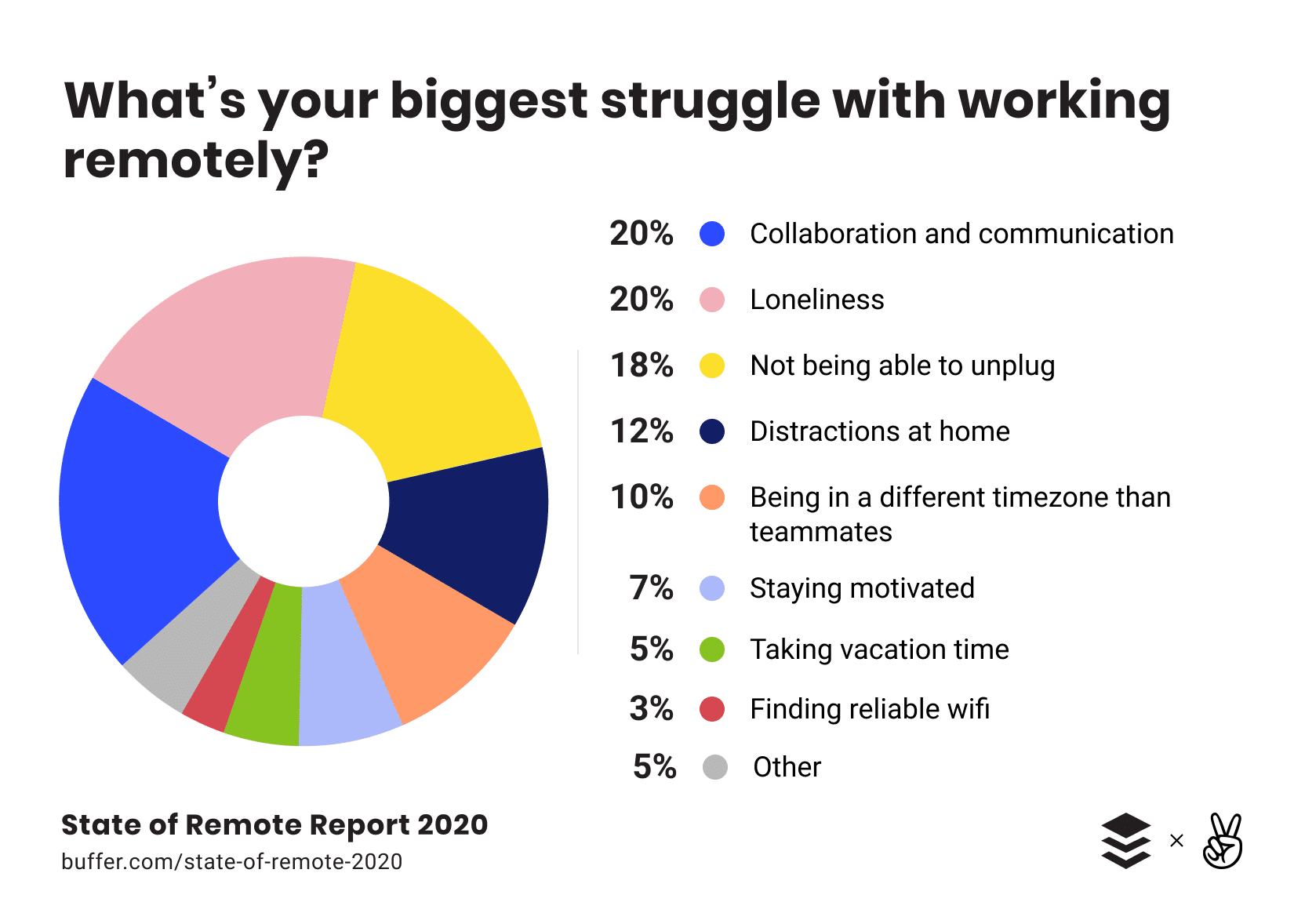
19. 18% of people said they find it hard to unplug. (Buffer)
When you step into an office environment, you know you’re in a place of work. When the two merge, it can be difficult, especially if you haven’t got the use of a home office. Therefore, it’s no surprise that some people find it hard to unwind and unplug when the working day.
Unplugging can be made easier if employees differentiate their home from their working space. Many people like to hot desk and rent a space in a co-working environment. This gives them the benefit of remote working while also allowing them time away from home.
20. Less than 50% of remote employees say they receive proper internet security training. (Business Wire)
An alarming remote working statistic from Business Wire has revealed that less than half of remote workers have received proper internet security training despite handling confidential business data. Managers should ensure that employees are equipped with security knowledge and training to protect valuable company information. This is especially vital for remote workers, as they’re often using their own network and devices, not the businesses.
21. 20% of people say loneliness is their biggest struggle when working remotely. (Buffer)
If your work line involves a lot of teamwork, it can be lonely being away from the office. This can particularly be the case if you live alone. Going into work provides human contact, which many people may miss. Co-working spaces can provide a social environment with other people in a similar situation.

Future of remote working
22. By 2022, the Global Mobile Workforce will be 1.87 billion people accounting for 42.5% of the total global workforce. (Strategy Analytics)
It’s predicted that working remotely will become more popular in the coming years. This is largely due to more people working remotely in 2020 than we could have predicted (many of whom enjoy working remotely), and advances in technology that allow teams to work together even though they’re apart.
23. 74% of companies plan to shift some of their employees to remote working permanently. (Gartner)
The companies surveyed revealed that they want to move at least 5% of their workforce to permanently remote positions after this year. This demonstrates that some businesses are prepared to allow employees to work more flexibly in the future.
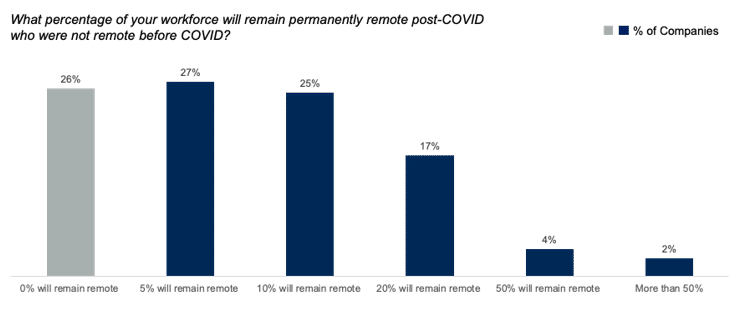
24. 73% of teams will have remote workers by 2028. (Upwork)
This statistic is based on a study of 1,000 hiring managers. 73% of departments will have remote workers, so most communication will likely be online via team messaging and video conferences to keep teams collaborating and informed.
25. 25-30% of the workforce will be working remotely from home by the end of 2021. (Global Workplace Analytics)
The increased demand in flexible working has been building for years, but in 2020 it came to a head. Now, more than ever, people expect flexible working options. Based on this statistic, it’s fair to say that some people will remain remote working into 2021.
Emerging remote work trends
Looking at the future of remote working statistics, there’s clearly a trend toward more people working remotely in the future. This doesn’t necessarily mean working from home, merely away from the office. All you need is a good WiFi connection, a laptop, and the right software to work from anywhere in the world. Here’s a look at some emerging remote work trends:
Co-working spaces for remote work
Not all employees find remote working easy. Some simply can’t concentrate with the distractions of being at home. Because of this, a key emerging trend is an increase in co-working spaces with fewer distractions. The graph below shows the number of coworking spaces worldwide, and predictions for rising soon.
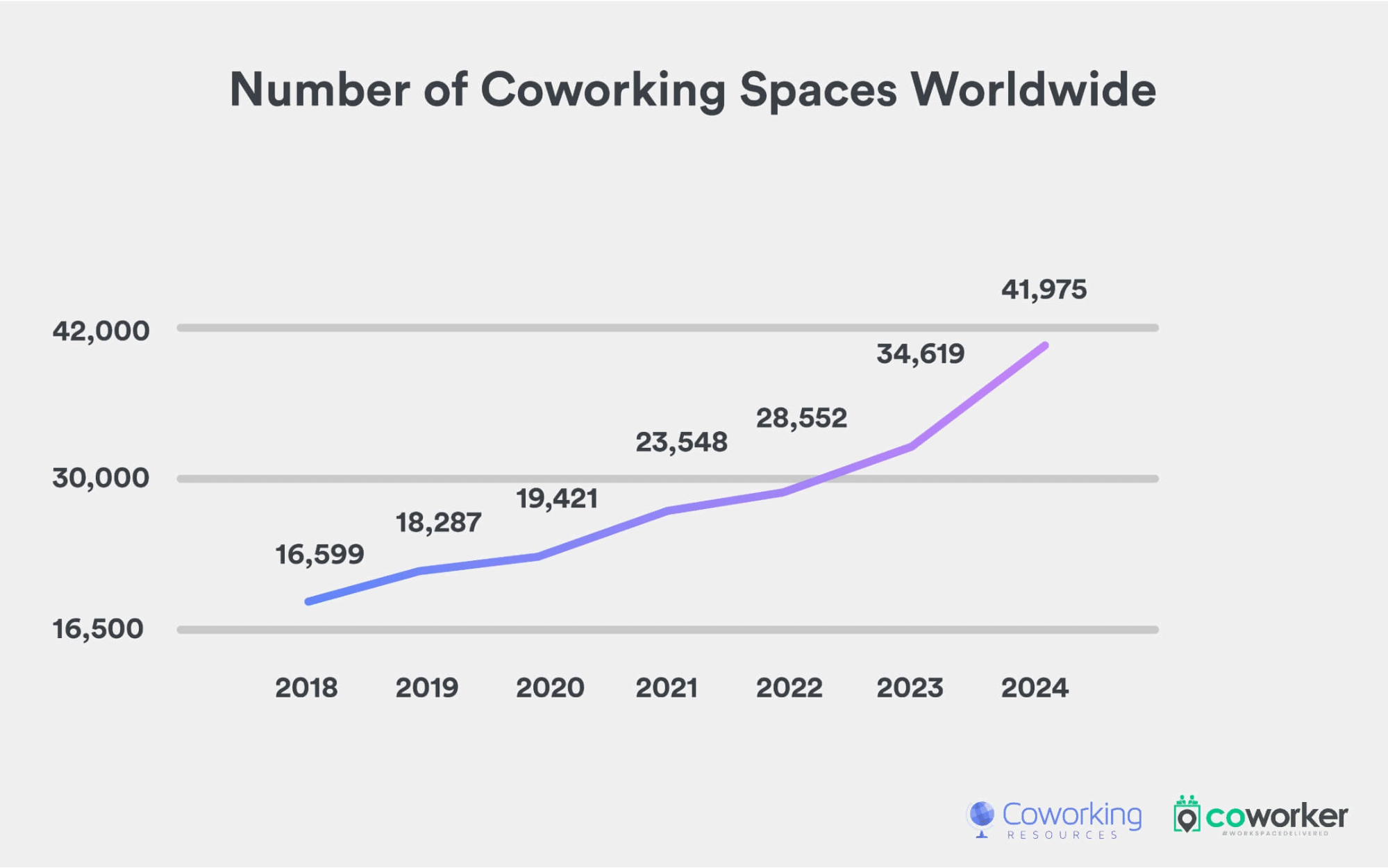
Co-working spaces aren’t just for the self-employed and freelancers. Many office workers prefer heading to a co-working space nearer to their home than commuting to the office each day. This gives them work options, and the freedom to work remotely on their own schedule. It can also reduce their carbon footprint.
For some startup businesses, open workspaces or hot-desking may be the only option available to them as they try to grow their business. Renting an entire office may not make good financial sense for a new business, whilst renting a single room or a few desks does.
Workforce planning is increasingly important.
A study by Upwork6 suggests that young Gen Z and Millennial managers are shaping the future of work, and 69% of them have team members who are allowed to work remotely. They can stay in touch by using communication software like RingCentral and hosting frequent meetings to keep up-to-date.
Given that Gen Z and Millennial managers will be director-level or higher, they’re going to have a major impact on remote work. The same Upwork survey also revealed the importance of workforce planning, with 52% of them saying they rank workforce planning as a top priority for their department.
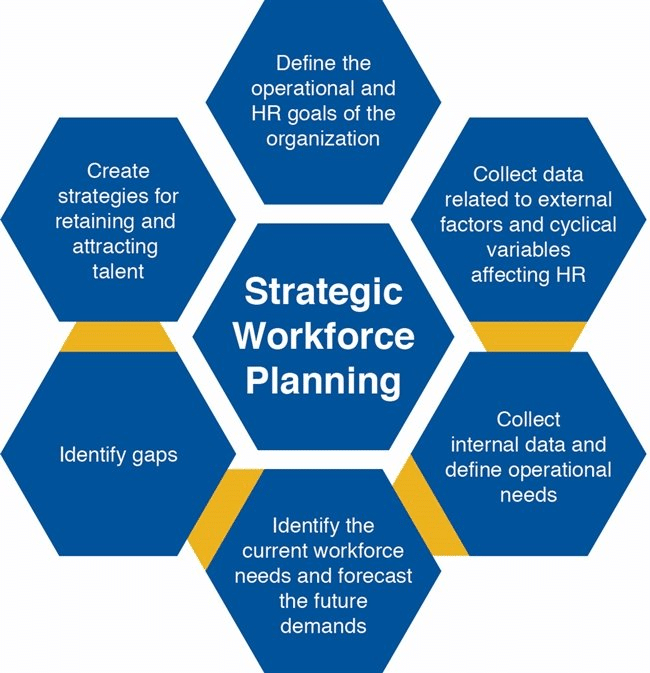
Workforce planning is an analysis of the current work environment. This involves establishing the workforce’s needs and any measures that can be put in place to improve the workday for employees. Businesses can then implement changes such as more hybrid working or flexible working hours, to suit their workers’ needs.
However, there is a balancing act here. Employers need to ensure the team’s right members are working together at the right time and the right cost. Careful planning and consideration are needed herein to help a business achieve its goals and mission statement.
It’s clear that the way the world works is changing, and emerging Gen Z leaders are at the forefront of this change.
People want a better work/life balance.
Before 2020, some people may never have been allowed to work from home. Now that they have, it appears that many people believe remote work can improve their work/life balance. A perhaps unsurprising hybrid working statistic is that 72% of people said they want to continue working from home because they get to spend more time with their family and have a better work/life balance7.
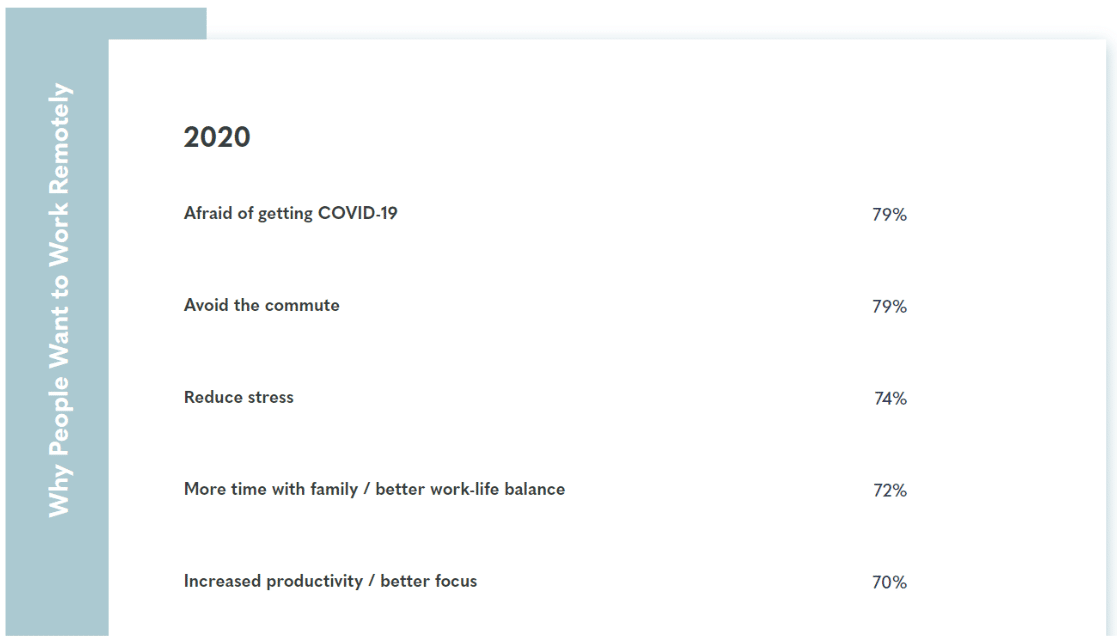
74% of people also stated that working remotely reduced their stress. Again, this demonstrates that working remotely can be a great thing for an employee’s wellbeing. If employees are happier and less stressed from being at home, they’ll likely want to keep it that way. Businesses will need to make changes to their flexible working opportunities if they want employees to have a better work/life balance.
What hybrid working looks like in 2021
Hybrid working is a mixture of office-based work and remote working. Employers allow their staff to have more flexible working schedules, choosing to come into the office when it suits them. This has created hybrid workforces, as some people decide to stay at home, and others prefer to head into the office.
Based on these statistics, it seems as though hybrid working will continue to increase as we move into 2021. What’s more, an increasing number of industries are introducing remote working policies as well. According to a study by Gallup8, finance, insurance, and real estate industries experienced the biggest surge in remote work. They were closely followed by transportation, manufacturing, and retail.
This goes to show that some industries have embraced remote work, even the unlikely ones. For example, real estate agents are usually out of the office for most of the day, as they meet with clients and view homes. Using video and audio calling software means they’re able to stay in touch with the office, while on-the-go – RingCentral’s work with Platinum Estates is a great example of this.

New communication tools
One of the pain points of remote work is a loss in communication9. Given that some teams may never all be in the office simultaneously during the week, it’s clear to see why this is a struggle for employees.
This means that businesses will need to invest in reliable communication tools to keep the team connected, no matter the state of their remote work situation where they are.

Tools like RingCentral were designed for bringing remote teams together. The all-in-one business communications solution features video and audio calling, as well as a range of other features, including:
- Team messaging
- A mobile app
- Enterprise-grade security
- App integrations
- An analytics portal
A platform like RingCentral makes the transition from working in the office to remote working seamless. You can even integrate your usual project planning tools and email accounts with the software, so you’ve got everything you need in one place. This is what the future of remote work looks like.
Wrapping up: Remote working statistics
Remote work is going to be part of the future. Although some people may not feel as ready for it as others, given time and effective training, sceptical employees may warm to the idea.
It’s time to embrace hybrid working as the needs of employees shift. Business owners should be open-minded. Employees who want to stay in the office part-time should be given that flexibility, as already offered by some employers.

To be prepared, businesses need to start investing in software to help their team stay productive when they’re working away from each other. And as we’ve seen, many businesses have already begun using video calling tools. Video conferencing software can help teams to collaborate and keep up-to-date across departments.
Ultimately, those businesses that are among the first to adopt this new working way of life will reap the benefits. It’s time to re-think the way you work. And, if you’re a manager, prioritising workforce planning is the next step. Evaluate the current strategies you have in place, and see how you can adapt them to meet the demand for remote work.
Sources
1 https://globalworkplaceanalytics.com/telecommuting-statistics
3 https://lp.buffer.com/state-of-remote-work-2020
4 https://www.owllabs.com/state-of-remote-work
5 https://www.owllabs.com/state-of-remote-work-uk/2020
6 https://www.gallup.com/workplace/283985/working-remotely-effective-gallup-research-says-yes.aspx
7 https://www.owllabs.com/state-of-remote-work
8 https://www.owllabs.com/state-of-remote-work/2020
10 https://www.owllabs.com/state-of-remote-work/2020
11 https://www.owllabs.com/state-of-remote-work/2020
12 https://lp.buffer.com/state-of-remote-work-2020
13 https://www.indeed.com/lead/remote-work-survey
14 https://www.airtasker.com/blog/the-benefits-of-working-from-home/
15 https://www.gallup.com/workplace/283985/working-remotely-effective-gallup-research-says-yes.aspx
16 https://globalworkplaceanalytics.com/telecommuting-statistics
17 https://www.owllabs.com/state-of-remote-work/2020
18 https://lp.buffer.com/state-of-remote-work-2020
19 https://lp.buffer.com/state-of-remote-work-2020
20 https://www.businesswire.com/news/home/20200122005406/en/
21 https://lp.buffer.com/state-of-remote-work-2020
24 https://www.upwork.com/press/releases/third-annual-future-workforce-report
Footnotes
1 https://globalworkplaceanalytics.com/telecommuting-statistics
2 https://www.owllabs.com/state-of-remote-work/2020
3 https://www.statista.com/statistics/1111396/benefits-of-working-remote-2020/
4 https://lp.buffer.com/state-of-remote-work-2020
5 https://www.owllabs.com/state-of-remote-work/2020
6 https://www.upwork.com/press/releases/third-annual-future-workforce-report
7 https://www.owllabs.com/state-of-remote-work/2020
8 https://www.gallup.com/workplace/283985/working-remotely-effective-gallup-research-says-yes.aspx
9 https://lp.buffer.com/state-of-remote-work-2020
Originally published Feb 08, 2021, updated Jan 16, 2023



